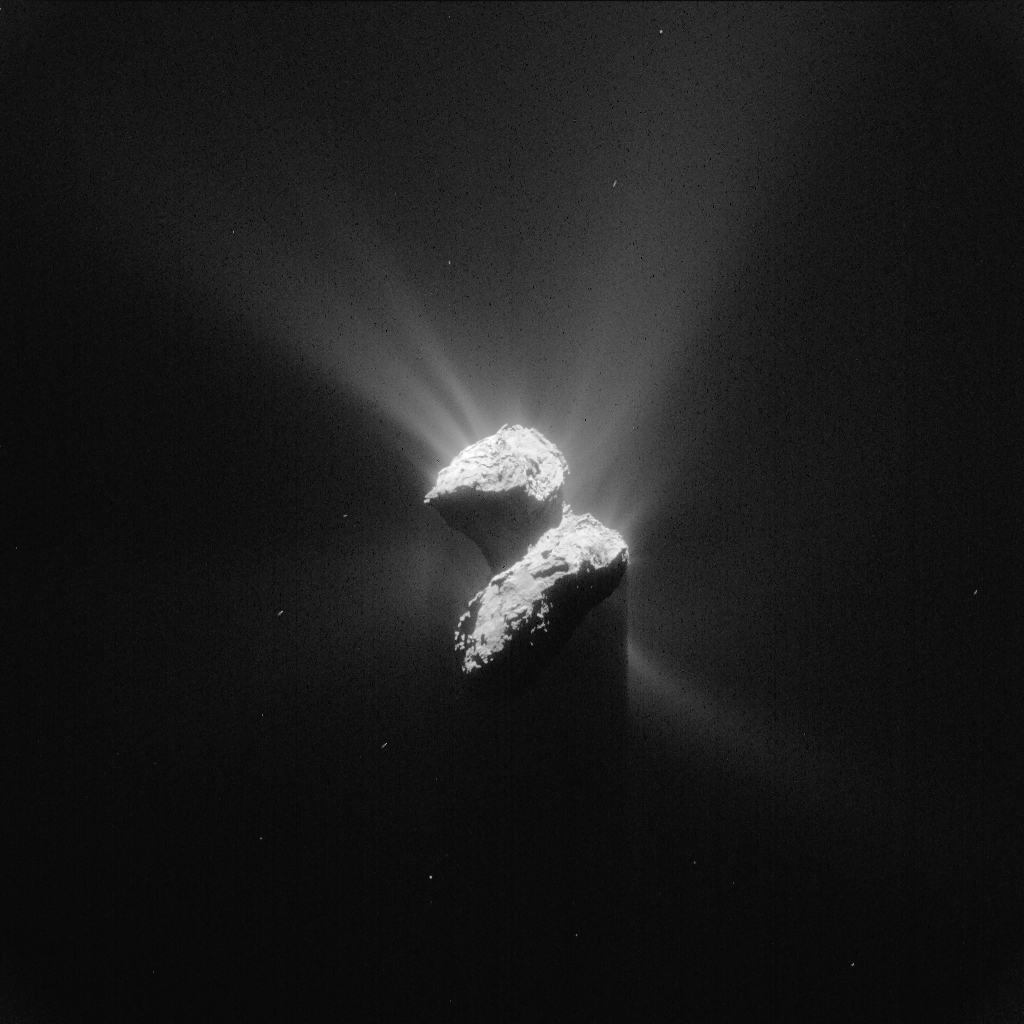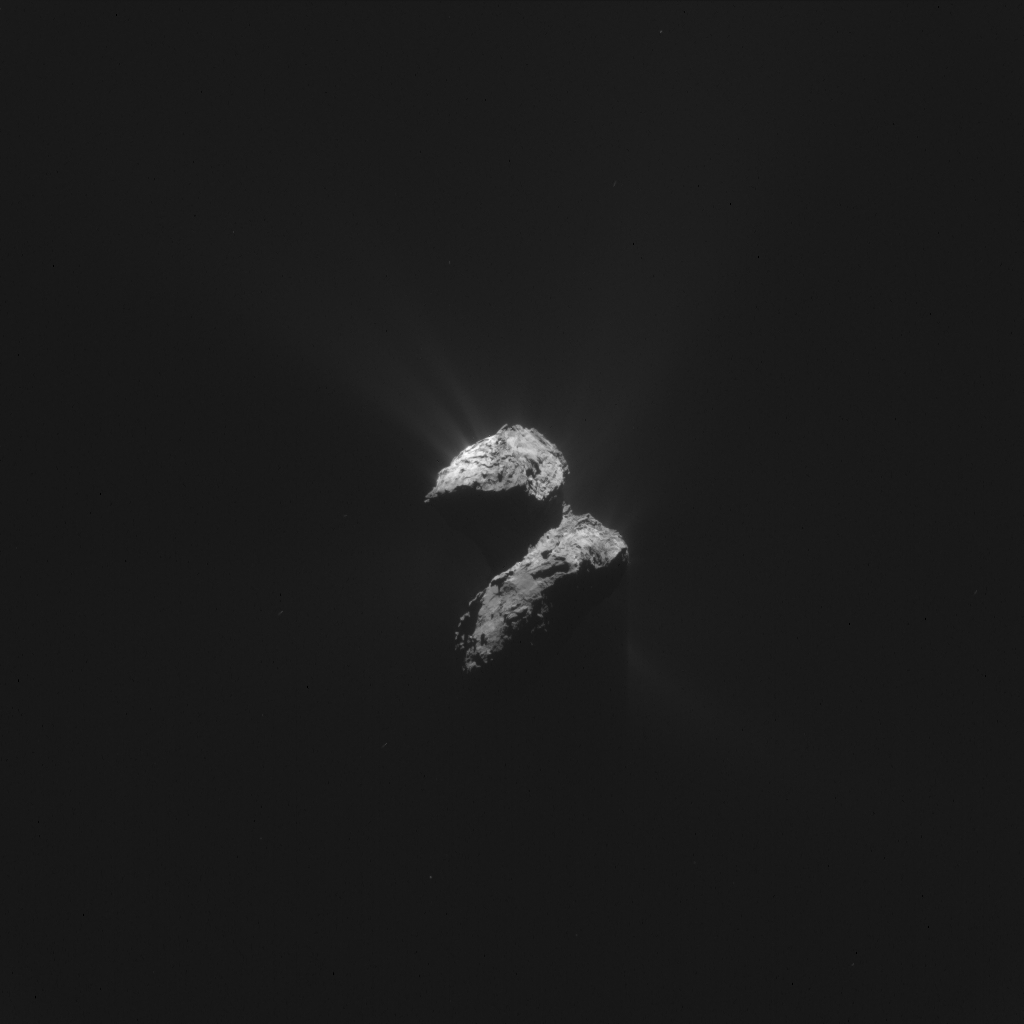Today’s CometWatch entry was taken on 5 June 2015, from a distance of 208 km from the centre of Comet 67P/Churyumov-Gerasimenko. The image scale is 17.7 m/pixel and the image measures 18.1 km across.

Processed NAVCAM image of Comet 67P/C-G taken on 5 June 2015. Credits: ESA/Rosetta/NAVCAM – CC BY-SA IGO 3.0
The image has been processed to bring out the details of the comet’s activity, which in this orientation shows off the spectacular display around the smaller of the two lobes.
The processed image also highlights the shadows cast by the two lobes across the background activity, in particular the sharp shadow and silhouetted large lobe towards the bottom of the scene.
The original 1024 x 1024 pixel image is provided below:










Discussion: 12 comments
Is there any data available about the current surface temperatures on the comet?
Judy
I haven’t seen anything for a while, Judy. However, there is a formula that one can use for a dark body (i.e. ignoring albedo) that was accurate to 1 K some months ago:
Temp Sun (K) * sqrt (radius Sun (AU)/distance (AU))
According to the Twitter feed thingy on the right, the comet was 218m km from the Sun on 11 June. That is ~1.45 AU.
Radius of the Sun = 0.00468 AU, and the temperature is 5780 K.
So, that gives ~328 K, or a rather toasty 55 C.
There is a hidden assumption, that the emissivity in the fairly far IR (for 200K, around 15um) is also high. Thats not a safe assumptiion for all materials (black anodised aluminium is the classic example. But 67P probably isnt made out of the 🙂 )
However the emissivity effects enter as a fourth root & so doesnt mess it up too much except in extreme cases.
So the formula is a good general guide, but I wouldnt want to claim 1K!
According to https://blogs.esa.int/rosetta/2015/06/14/rosettas-lander-philae-wakes-up-from-hibernation/ Philae is reporting operating at a balmy -35ºC. But that’s operating temperature, and I would assume the ambient temperature is a bit cooler.
Interesting with the shadow interaction below the big lobe. The jet that is being cut by the shadow must have its origin somewhere in Imhotep. But that area have been in shadow for about two hours at the time of exposure and still it is very strong.
The image nicely shows, that the brightness of the dust jets isn’t intrinsic, but by illumination from the Sun.
If that were the case Gerald the pick up and transport of dust by the gas jets would have to be extremely uniform and consistent, unbelievably so, to account for such uniform and uninterrupted brightness in the jets.
Continuous solar illumination, hence continuous warming additionally dampened by the dust layer, hence continuous sublimation, hence continuous jets during comet daytime.
Uniform solar illumination of the jets outside the shadow, uniform scattering of light by the jets.
Did I miss something?
You did miss quite a lot Gerald,
Did the jet come from a hole in the ground in which case some dust came from the hole, presumably slowly increasing as the hole gets bigger assuming ice is underground.
Or did the column of dust & gas erupt from the surface that was evenly illuminated, in which case, why are the columns circular and parallel -ish and where is the ice to sublimate?
With both issues you need a constant supply of dust from the hole or the surface or both, even though the scouring process would surely find different thicknesses of dust and begin to starve itself as the dust being picked up is at a greater distance from the jet or from the base of the surface erupting jet.
There are many other issues you have brushed aside.
The comet consists of ices and dust. As the ices sublimate, the released gas drags the dust portion.
That’s sufficient to understand the overall mechanism.
There may be several possible mechanisms in detail, but the outcome is similar. Hence for a rough understanding of the continuity of the jets, you can leave such detail in a black box.
makes my day!!
Thank you
Good morning, Philae-sophy!